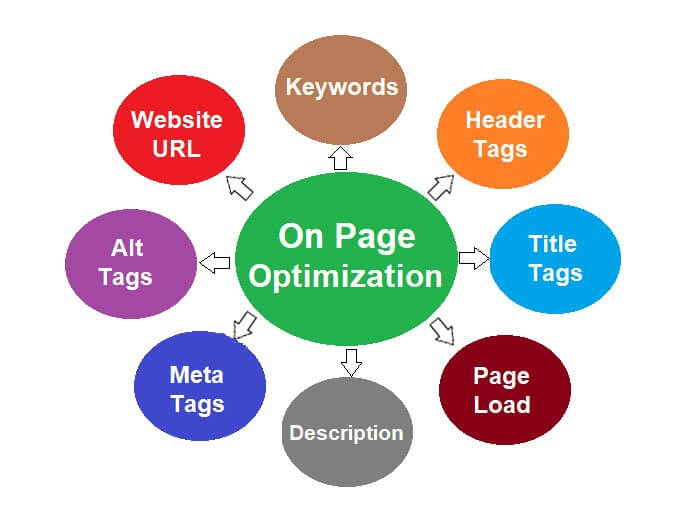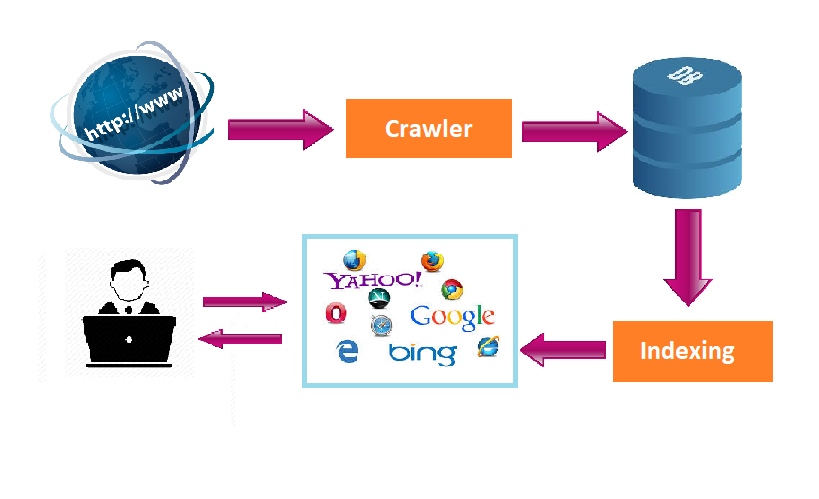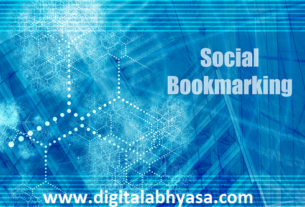On-Page Optimization:
An on-page optimization technique is a technique which is used for optimizing the website according to SEO guidelines. It is the optimization of factors on a web-page (It includes both content and HTML code).
On-Page Optimization elements are
- Website/Domain Name
- Website URL
- Keywords
- Title Tags
- Meta Tags
- Alt Tags
- Web-page Content
- Internal Links
- Page Load
- Sitemaps
- Canonicals
- Robots.txt
- Performance Of Page
What is a Domain Name?
Domain Name is the address of your Website. If you want to start a business using the internet, you need to think about your domain name because internet users acess your website using your domain name.
6 tips while choosing the perfect domain name
- Unique
- Domain Name must be short
- Easy to remember
- Use the Target Keyword in the domain name
- Choose the best domain name extension
- Target Audience
4 Mistakes to avoid while choosing the perfect domain name
- Numbers
- Hyphens
- Longer Domain Name
- Hard to remember
5 Best sites to buy a domain name
- Go Daddy,
- HostGator
- Dreamhost
- Bluehost
- Namecheap
What is a Website URL?
URL (Uniform Resource Locator) is the location of the website/webpage on the internet.
Example:
http://www.digitalabhyasa.com/
Types of URLs:
- Static URL
- Dynamic URL
Static URL:
A static URL (uniform resource locator) is a website address based on the name that is direct, invariable, clear and does not contain user identification information or session.
Example:
www.digitalabhyasa.com/seo/tutorials/
Dynamic URL:
A Dynamic URL is a website address based on parameters and values.
Example:
http://www.abc.com/seo1/111480/
3 Important Things:
- Use the Target Keyword in the URL
- Separate Keywords with symbols
- Don’t use Capital Letters in URL
OPTIMIZATION OF KEYWORDS IN SEO:
WHAT IS A KEYWORD?
- The keyword is a word or phrase to describe the contents of a Web page.
- It is used to rank a web page. When the user searches with a keyword or a phrase in search engines. Google uses that Keyword to determine what content is relevant to a particular search query.
While you are post something on Google, the main important thing is Keyword.
IMPORTANCE OF KEYWORDS:
- A keyword is used to rank a web page.
- Use a Proper Keyword to get more Search Traffic.
- Keyword density helps to increase ranking in your niche.
- To increase the domain authority fast.
What is KEYWORD FREQUENCY?
Keyword frequency and keyword density are two different terms for the same rule. Simply Keyword Frequency is, how often a keyword appears on a web page.
What does KEYWORD WEIGHT mean?
It is nothing but the number of keywords appears on your Web page compared to the total number of words appears on the same Web page.
PUT YOUR KEYWORDS IN THE 7 BEST PLACES:
- Domain Name
- Website URL
- Page title
- Header Tags
- Page Description
- Alt Tags
- Internal Links
KEYWORD RESEARCH:
The process of finding the best suitable keywords for SEO Rankings.
6 BEST SEO KEYWORD RESEARCH TOOLS YOU NEED TO KNOW:
Title Tags:
In SEO, Title tags are the Html element of your page that indicates Title. It is used for the user and also the search engine to know about the content of a webpage.
Example:
<head>
<title>Digital Abhyasa – A Guide for SEO Learners</title>
</head>
3 Important factors for Title Tag Optimization:
- Use target keywords in title tags
- Take one unique Title tag for each page
- Better to use 55 to 65 characters in the title tag
Meta Tags:
Meta tags are the most important element in SEO because they are used to define the information for Search Engine.
3 Important Meta Tags are:
1. Keywords
2. Meta Description
3. Meta Robots
Meta Keywords:
A keyword is nothing but a word or phrase in your web content. Meta keywords are the keywords of your website.
–> Meta keywords are important because helps the users to find your website in search engines.
–> As per Google, Meta tags are not useful for ranking your page in search engine result page.
Example:
<meta name=”Keywords” content=”SEO”, “Digital Marketing”, “Tutorials”, “Meta Tags”, “On-page optimization”/>
Meta Description:
Meta Description is nothing but the content of your webpage is about. Search Engine shows the Meta description in the search result page when searched for keywords in Search Engine.
–> Meta descriptions are important to you, to get SEO rankings in SERP.
–> Use Targeted Keywords in Meta Description and it should be relevant to the webpage.
Example:
<meta property=”og: description” content=” Digital abhyasa is all about to learn tutorials for SEO for beginners to Advanced Level. A simple and easy way to learn SEO tutorials. What is SEO, On-page optimization, Off-page Optimization, and Link-Building.”
Length of a Meta description:
–> Meta Description length should be in between 155 to 165 characters.
–> From 2017 onwards Google shows the Meta Description length up to 300 characters in Search Engine Result Page.
Meta Robots:
Meta robots are used to give instructions to the Search Engine for crawler and indexing webpage content.
Example:
<META NAME=”ROBOTS” CONTENT=”Index, Nofollow”>
Index: Index used to tells a search engine to index a web page.
Noindex: Noindex used to tells a search engine not to index a Web page.
Follow: Even if the web page is not indexed, the crawler must follow all the links on a web page and pass the net value to the linked web pages.
Nofollow: Nofollow Used to tell a crawler not to follow any links on a web page or pass along any link value.
Header Tags:
One of the important On-Page SEO techniques is Header Tags. Header tags are the headings and subheadings of your web page.
Examples:
- <h1>Digital Abhyasa for SEO Tutorials</h1>
- < h2>On-Page Optimization</h2>
- < h3>Off-Page Optimization</h3>
- < h4>Tools</h4>
- < h5>Google Ad words</h5>
- < h6>Google Analytics</h6>
Optimization of header tags:
- Use only one h1 tag per page.
- You can use multiple h2 and h3 tags per page.
- Use targeted keywords in Header tags.
Alt Tags:
An alt tag is known as an attribute; applied to an image tag to describe the content of an image.
If the image file can’t be loaded, the alt tag is used to display in place of an image.
Search Engine can read the image data by using Alt Tag.
Optimization of Alt Tag:
Use at least one image on a web page.
Use Target keyword in the alt tag.
Example:
<img src=”digitalabhyasa.png” alt=”SEO Tutorial”>
Web Page Content:
Content is one of the main important techniques in SEO to get rank in SERP. Simply we can say content is the king in SEO. Whatever you see on the web page, is content.
- Use High-Quality content.
- Your content should be reaching the targeted audience.
- Use Keywords in your content.
- The density of the page can be between 2% to 4% on the article length.
- Better to divide the content of your web page into short paragraphs.
- Use/give links to other pages in your content.
- It helps you; the users can stay longer on your website.
- If you have good content on your website, this will be used to get good rank in Search Engine.
- Better to avoid stuffing keywords.
- Your content should be useful for your user, what they want exactly.
- Don’t use complex language.
- Don’t use duplicate content.
Links:
Two types of links we have,
- Internal Links
- External Links
Internal Links:
- Internal links are also called as Inbound Links.
- They are the navigations from one web page to another web page on the same website.
- Internal links are important, to improve the quality of your web pages.
- Internal links are useful, to pass the page authority from one web page to another web page.
- Useful for the users, to navigate easily from one web page to another.
External Links:
- External links are also called as Outbound Links.
- External links are navigations from one website to another website.
- Useful to increase the domain authority of your website from other websites.
Page Speed:
- Page speed is one of the important factors in On-Page Optimization.
- Google has indicated the speed of the Website is one of the signals used by its algorithm to rank the pages.
- Page speed is the amount of time taken by the website to load in the user browser.
- Generally, most of the users spend only 10 Seconds on a site.
- If your website loads fast, it is good for your users can stay longer on your website.
4 Page Speed Checker Tools are:
- Google Speed Analyzer
- GT Metrix
- Pingdom
- SEO Chat
Sitemaps:
A sitemap is a file which has provides access to all the links in the website.
We have 2 types of Sitemaps, they are
Html Sitemaps:
Html Sitemaps are used for the users.
XML Sitemaps:
- An XML sitemap is a list of your website URLs.
- XML sitemaps are used for the Search Engine.
- For static websites we use www.xml-sitemaps.com.
- You can create sitemaps in www.xml-sitemaps.com.
What is Canonicalization?
Canonization is an HTML element.
It is a process that tells the search engine that a specific URL represents a master copy of a web page. The use of the canonical tag prevents problems caused by identical or “duplicate” content from appearing in several URLs.
How to apply a canonical tag:
On the web pages that you want the Search engine to recognize as canonical, add a link tag to the HTML code header.
Example:
<link rel=”canonical” href=”http://www.digitalabhyasa.com/” />
Robots.txt:
The purpose of Robots.txt file is to control the access of Crawler in our website.
Robots.txt File:
User-agent: (name of the user agent)
Disallow: (The URL you want not to crawled by Search Engine)




Good Content posted by you. It would be helpful to me, if you can share any other link to learn.
Thanks for sharing